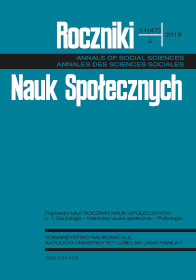A Political Act in the E-Society: Digital Vigilantism and Swarms
Abstract
The main aim of this article is, by using the case of digital vigilantism, to analyze what new challenges could occur in the E-society and how understanding of the self and self-act is changing during the process when more and more new technologies are integrated in people’s everyday life. The swarm is a metaphor which Zygmunt Bauman uses to show how the understanding of communities is changed in liquid modernity. Swarms are based on untied, uncontrolled, short-term relationships between consumers/users to achieve some goals. Swarms could be massive in numbers and have a lot of power for a very short period. One of the examples could be digital vigilantism, which is an act of punishing certain citizens (they are believed to deserve punishment) by other Internet users. One example of DV would be to put personal information on display to spread shaming acts. The problem is that people are interested in some actions for a very short time, but the political act/change requires an active and stable effort. Despite the phenomenon of DV not getting much attention from the field of political science or political philosophy, it provides us with some insights about the current changes in our understanding of politics and the concept of what is “political” as well as inviting us to reconsider the idea of swarms as put forward by Bauman.
References
Andrews, Robert. “Baiters teach Scammers a Lesson.” Wired, April 8, 2006. https://www.wired.com/2006/08/baiters-teach-scammers-a-lesson.
Balabanian, Norman. “On the Presumed Neutrality of Technology.” IEEE Technology and Society Magazine 25, no. 4 (2006): 15–25.
Bauman, Zygmunt. Consuming Life. Cambridge: Polity Press, 2007.
Brey, Philip. “Philosophy of Technology after the Empirical Turn.” Techné: Research in Philosophy and Technology 14, no.1 (2010): 36–48.
Cheong, Pauline H., and Jie Gong. “Cyber Vigilantism, Transmedia Collective Intelligence, and Civic Participation.” Chinese Journal of Communication 3, no. 4 (2010): 471–87.
Clune, Bronwen. “Digital Vigilantism Think Before Putting Pictures of Wrongdoing Online.” The Guardian, November 29, 2013. https://www.theguardian.com/commentisfree/2013/nov/29/digital-vigilantism-think-before-pictures-of-wrongdoing-online.
Dementavičienė, Augustė. “Kaip naujosios technologijos nulemia politinio veiksmo suvokimą: Digital Vigilantism atvejis?” Politologija 95, no. 3 (2019): 33–55.
Dennis, Kingsley. “Keeping a Close Watch — The Rise of Self-Surveillance and the Threat of Digital Exposure.” The Sociological Review 56, no. 3 (2008): 347–57.
Favarel-Garrigues, Gilles. “Digital Vigilantism and Anti-Paedophile Activism in Russia. Between Civic Involvement in Law Enforcement, Moral Policing and Business Venture.” Global Crime (October 21, 2019): 1–21. https://doi.org/10.1080/17440572.2019.1676738.
Fortey, Ian, “8 Awesome Cases of Internet Vigilantism.” Cracked, March 23, 2009. http://www.cracked.com/article_17170_8-awesome-cases-internet-vigilantism.html.
Foucault, Michel. The History of Sexuality. Vol. 1, An Introduction. New York: Vintage, 1990.
Fuchs, Christian. Social Media: A Critical Introduction, London: Sage, 2017.
Gabdulhakov, Rashid. “Citizen-Led Justice in Post-Communist Russia: From Comrades’ Courts to Dotcomrade Vigilantism.” Surveillance & Society 16, no. 3 (2018): 314–31.
Gabdulhakov, Rashid. “In the Bullseye of Vigilantes: Mediated Vulnerabilities of Kyrgyz Labour Migrants in Russia.” Media and Communication 7, no. 2 (2019): 230–41.
Haraway, Donna J. Manifestly Haraway. Posthumanities 37. Minneapolis: University of Minnesota Press, 2016.
Heidegger, Martin. The Question Concerning Technology and Other Essays, 287–317. New York: Harper & Row, 1977.
Hill, Colin. “How Digital Communities Cope: Cyber-vigilantism Following the Boston Marathon Bombings.” The Yale Review of International Studies (April 2017). http://yris.yira.org/essays/2039.
Johnston, Les. “What is Vigilantism?” The British Journal of Criminology 36, vol. 2 (1996): 220–36.
Kasra, Mona. “Vigilantism, Public Shaming, and Social Media Hegemony: The Role of Digital-Networked Images in Humiliation and Sociopolitical Control.” The Communication Review 20, no. 3 (2017): 172–88.
Key. “Sue Me If You Dare, My Dad Is Li Gang.” Chinahush, October 21, 2010. http://www.chinahush.com/2010/10/21/sue-me-if-you-dare-my-dad-is-li-gang/.
Kingsley, Denis. “Keeping a Close Watch — the Rise of Self-surveillance and the Threat of Digital Exposure.” The Sociological Review 56, no. 3 (2008): 347–57.
Kudělka, Miloš, Zdeněk Horák, Václav Snášel, Pavel Krömer, Jan Platoš, and Ajith Abraham. “Social and Swarm Aspects of Co-authorship Network.” Logic Journal of the IGPL 20, no. 3 (2012): 634–43.
Kucera, Michal, and Miroslav Mares. “Vigilantism during Democratic Transition.” Policing and Society 25, no. 2 (2015): 170–87.
Kwong, Henry, and Christian Jacob. “Evolutionary Exploration of Dynamic Swarm Behaviour.” Paper presented at the 2003 Congress on Evolutionary Computation, Canberra, Australia, December 8–12, 2003. IEEE (May 24, 2004). doi:10.1109/CEC.2003.1299599.
Loveluck, Benjamin. “The Many Shades of Digital Vigilantism. A Typology of Online Self-justice.” Global Crime (June 4, 2019): 1–29. https://doi.org/10.1080/17440572.2019.1614444.
Palese, Emma. “Zygmunt Bauman. Individual and Society in the Liquid Modernity.” SpringerPlus 2, no. 1 (2013): 191. https://doi.org/10.1186/2193-1801-2-191.
Ronson, Jon. “Strange Answers to the Psychopath Test.” TED, March 2012. https://www.ted.com/talks/jon_ronson_strange_answers_to_the_psychopath_test.
Sharon, Tamar. “Self-tracking for Health and the Quantified Self: Re-articulating Autonomy, Solidarity, and Authenticity in an Age of Personalized Healthcare.” Philosophy & Technology 30, no. 1 (2017): 93–121.
Smallridge, Joshua, Philip Wagner, and Justin N. Crowl. “Understanding Cyber-Vigilantism: A Conceptual Framework.” Journal of Theoretical & Philosophical Criminology 8, no. 1 (2016): 57–70.
Smith, Gregory B. “Heidegger, Technology and Postmodernity.” Social Science Journal 28 (1991): 369–89.
Tanner, Samuel, and Aurélie Campana. “‘Watchful citizens’ and Digital Vigilantism: A Case Study of the Far Right in Quebec.” Global Crime (April 26, 2019): 1–21. https://doi.org/10.1080/17440572.2019.1609177.
Trottier, Daniel. “Digital Vigilantism as Critical Reinforcement of Law and Order.” Re.Framing Activism, April 6, 2016. http://reframe.sussex.ac.uk/activistmedia/2016/04/digital-vigilantism-as-critical-reinforcement-of-law-and-order.
Trottier, Daniel. “Coming to Terms with Social Media Monitoring: Uptake and Early Assessment.” Crime, Media, Culture 11, no. 3 (2015): 317–33.
Trottier, Daniel. “Digital Vigilantism as Weaponisation of Visibility.” Philosophy & Technology 30, no. 1 (2017): 55–72.
Trottier, Daniel. Social Media as Surveillance: Rethinking Visibility in a Converging World, 1–7. New York, Routledge, 2016.
Van Dijck, José. “‘You have one identity’: Performing the Self on Facebook and LinkedIn.” Media, Culture & Society 35, no. 2 (2013): 199–215.
Copyright (c) 2019 Roczniki Nauk Społecznych

This work is licensed under a Creative Commons Attribution-NonCommercial-NoDerivatives 4.0 International License.


